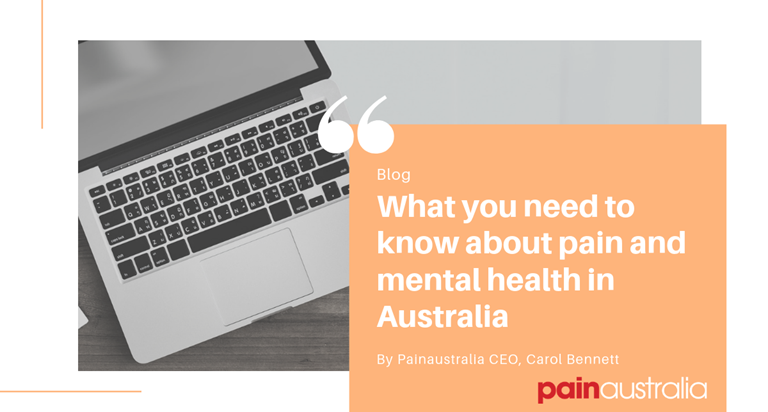Chronic pain is not just uncomfortable or inconvenient. It deeply affects the capacity to work, mental health and wellbeing as well as relationships. Distressingly, it can also end in suicide.
This is what we know today:
· Rates of mental health and suicide are higher amongst people living with pain.
· Major depression is the most common mental health condition associated with chronic pain, with among 30-40% of people with a diagnosed mental health condition also presenting for treatment for chronic pain.
· High rates of generalised anxiety disorder, post-traumatic stress disorder and substance misuse are often present for people living with chronic pain.
· Almost a third of Australian adults with severe or very severe pain experience high levels of psychological distress; around three times the rate of those with mild pain and six times the rate of those with no pain.
· One in five Australian adults with severe or very severe pain suffer depression or other mood disorders.
· Suicidal behaviour is also two to three times higher in people with chronic pain than the general population.
These facts are momentous. Yet, as Painaustralia’s submission to the Victorian Royal Commission into menta health (2019) outlines, despite a strong link between pain and mental health, chronic pain remains a poor cousin in policy priority and public awareness – in short, it remains misunderstood and neglected.
Furthermore, there are a number of significant barriers to Australians accessing the mental health care and support that people with chronic pain need and deserve.
1. Lack of access
a. Most people with chronic pain do not have access to best practice pain services, which includes mental health care. This is typically due to location and/or cost, with a lack of services in rural and remote areas. Stigma about chronic pain and mental health conditions also prevent people from seeking and receiving treatment.
Design and service delivery addressing key access issues must take into account the nexus between mental health and pain conditions to ensure early intervention and improve long term outcomes.
2. Absence of understanding of the biopsychosocial approach
a. Expert consensus and a growing body of research in Australia and worldwide says best-practice pain management that most effectively improves function and mood requires coordinated interdisciplinary assessment and management involving assessing, at a minimum, physical, psychological, and environmental risk factors in each patient.
We need to see a biopsychosocial model of best practice adapted to capture the overlap in the treatment pathways of those with mental health and chronic pain conditions.
3. Significant treatment disparity among states and territories
a. Commitments have been made by various jurisdictions to improve the understanding of pain in the community and health sector and address gaps in access to pain services. However, a firm commitment from all levels of government is urgently required, one that draws on existing programs and leverages investments.
4. Lack of consumer awareness
a. Pain and pain management remains misunderstood in the wider community. Patient and community beliefs about chronic pain including stigma, a perceived lack of credibility or empathy and not being believed leaves people with chronic pain feeling isolated, unable to seek or access good quality pain management – which includes mental health services. Many are reliant on medications as a result, often with harmful effects. Many people are simply not aware of what treatments are available. We need to develop consumer and health awareness programs that highlight the inter-relationship between mental health and chronic pain.
Recent years have seen a significant growth in people’s understanding and awareness of mental health problems, which is undeniably a great thing. We now need to extend this awareness to link with chronic pain and educate the health care sector and public about the signs and symptoms that show pain is taking a toll on someone’s mental health and the avenues that are available to offer help and assistance.
Painaustralia will continue to advocate for the implementation of a national biopsychosocial approach made accessible for all Australians in order to reduce this incredibly weighty toll of poor mental health affecting the millions of us living with chronic pain.
Carol Bennett, CEO
